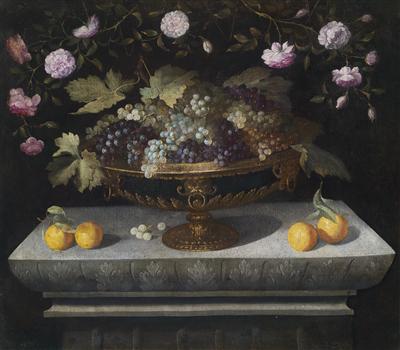Bernardo Polo

(active in Saragossa in the second half of the 17th century)
Dish of fruit with grapes, oranges and roses,
oil on canvas, 85 x 98, framed
Provenance:
European private collection.
We are grateful to William B. Jordan for identifying the artist.
Until recently, Bernardo Polo was known by the name, ‘Pseudo-Hiepes’. In 2009 William Jordan succeeded in his article, ‘El Pseudo-Hiepes es Bernardo Polo,’ Archivo Español de Arte, LXXXII, no. 328 (October - December 2009), pp. 395-403, in identifying the works of this anonymous artist as those of Bernardo Polo, after a signed work was discovered.
The charming and very decorative bodegones by Bernardo Polo are believed to have enjoyed great popularity, so that one may assume that he ran a large workshop. The repetition of motifs and the varied ordering of individual elements are reminiscent of the working method, which Juan van der Hamen had introduced fifty years before in his workshop in Madrid.
William Jordan described three compositional types, under which headings most of Polo’s oeuvre falls. To the first group belong pictures, such as the present painting, which depict individual dishes of fruit on square, free-standing stone socles. The painting signed by Polo, ‘Salver with melons, apricots and plums’ in a private collection (op. cit. p. 395, ill. 2) would also be assigned to this category. It is also distinguished by lighting effects typical of the artist which come from a strong light source at the upper left, dividing the picture in half diagonally.
The second group includes still lifes largely with symmetrically placed objects on a stone platter with chiselled foliate motifs (see ‘Still life with vase of flowers, dish of fruit and wine cooler’, private collection, Barcelona, op. cit. p. 397, ill. 4). The third group includes paintings in which the objects are arranged on a cabinet (see ‘Cabinet with desserts, doves and a vase of flowers’, private collection, Madrid, op. cit. p. 401, ill. 9). The individual elements are arranged frontally in all of the works.
Still life painting spread throughout Spain in the second quarter of the 17th century. Particularly popular were still lifes with few objects, and with food and cutlery on a table. In contrast to the rich Dutch banqueting scenes with their luxurious objects these works are characterised by a starker conception. The background is generally neutral and dark, creating a surreal mood. Unlike Northern European still lifes with their abundance and underlining of sensual pleasures, the Spanish still lifes are fascinating in their sparseness and sobriety.
Little is known about the life and work of Bernardo Polo. He is mentioned in Palomino and Ceán Bermudez as a ‘painter of flowers and fruit after nature’ active in Saragossa, whose works are also highly estimed in Madrid. He is presumed to have died circa 1700.
17.04.2013 - 18:00
- Estimate:
-
EUR 40,000.- to EUR 60,000.-
Bernardo Polo
(active in Saragossa in the second half of the 17th century)
Dish of fruit with grapes, oranges and roses,
oil on canvas, 85 x 98, framed
Provenance:
European private collection.
We are grateful to William B. Jordan for identifying the artist.
Until recently, Bernardo Polo was known by the name, ‘Pseudo-Hiepes’. In 2009 William Jordan succeeded in his article, ‘El Pseudo-Hiepes es Bernardo Polo,’ Archivo Español de Arte, LXXXII, no. 328 (October - December 2009), pp. 395-403, in identifying the works of this anonymous artist as those of Bernardo Polo, after a signed work was discovered.
The charming and very decorative bodegones by Bernardo Polo are believed to have enjoyed great popularity, so that one may assume that he ran a large workshop. The repetition of motifs and the varied ordering of individual elements are reminiscent of the working method, which Juan van der Hamen had introduced fifty years before in his workshop in Madrid.
William Jordan described three compositional types, under which headings most of Polo’s oeuvre falls. To the first group belong pictures, such as the present painting, which depict individual dishes of fruit on square, free-standing stone socles. The painting signed by Polo, ‘Salver with melons, apricots and plums’ in a private collection (op. cit. p. 395, ill. 2) would also be assigned to this category. It is also distinguished by lighting effects typical of the artist which come from a strong light source at the upper left, dividing the picture in half diagonally.
The second group includes still lifes largely with symmetrically placed objects on a stone platter with chiselled foliate motifs (see ‘Still life with vase of flowers, dish of fruit and wine cooler’, private collection, Barcelona, op. cit. p. 397, ill. 4). The third group includes paintings in which the objects are arranged on a cabinet (see ‘Cabinet with desserts, doves and a vase of flowers’, private collection, Madrid, op. cit. p. 401, ill. 9). The individual elements are arranged frontally in all of the works.
Still life painting spread throughout Spain in the second quarter of the 17th century. Particularly popular were still lifes with few objects, and with food and cutlery on a table. In contrast to the rich Dutch banqueting scenes with their luxurious objects these works are characterised by a starker conception. The background is generally neutral and dark, creating a surreal mood. Unlike Northern European still lifes with their abundance and underlining of sensual pleasures, the Spanish still lifes are fascinating in their sparseness and sobriety.
Little is known about the life and work of Bernardo Polo. He is mentioned in Palomino and Ceán Bermudez as a ‘painter of flowers and fruit after nature’ active in Saragossa, whose works are also highly estimed in Madrid. He is presumed to have died circa 1700.
|
Buyers hotline
Mon.-Fri.: 10.00am - 5.00pm
old.masters@dorotheum.at +43 1 515 60 403 |
| Auction: | Old Master Paintings |
| Auction type: | Saleroom auction |
| Date: | 17.04.2013 - 18:00 |
| Location: | Vienna | Palais Dorotheum |
| Exhibition: | 06.04. - 17.04.2013 |
